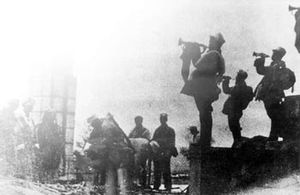- Siege of Changchun
-
Siege of Changchun Part of the Chinese Civil War 
Changchun after the siegeDate May 23 - October 19, 1948 Location Changchun and proximity Result People's Liberation Army captures Changchun Belligerents  National Revolutionary Army
National Revolutionary Army People's Liberation Army (Northeast and North China Field Army)
People's Liberation Army (Northeast and North China Field Army)Commanders and leaders  Zheng Dongguo
Zheng Dongguo Lin Biao
Lin Biao
 Xiao Jingguang
Xiao JingguangStrength ~100,000 100,000 Casualties and losses 95,000; ~330, 000 civilian deaths [1] minimal The Siege of Changchun (simplified Chinese: 长春围困战; traditional Chinese: 長春圍困戰; pinyin: Chángchūn Wéikùnzhàn) was a siege operation launched by the People's Liberation Army during the Chinese Civil War against the city of Changchun, defended by the Nationalist forces. The Siege of Changchun was part of the Liaoshen Campaign, and the fall of Changchun marked the end of the first stage in Liaoshen Campaign.
Beginning on May 23, 1948, the People's Liberation Army began to encircle the Nationalist defenders in Changchun, while cutting off air transportation. The siege would last for 150 days. The siege ended when the People's Liberation Army entered Changchun after the Nationalist 60th Army and New 7th Army surrendered.
Lin Biao commanded the Communist forces during the siege. Lin had initially proposed to move on Changchun in April, but turned his attention to other cities after investing Changchun. In October, Lin proposed to finally take the city. In response, Mao sent a sarcastic telegram ridiculing him for not having taken the city five months prior, and ordering Lin to take Jinzhou instead.[2] As news from Jinzhou reached Changchun, the KMT commanding general, Ceng Zesheng, defected to the Communists along with most of his officers. They were given posts in the Communist armies on Mao Zedong's personal orders.[3]
Civilian Starvation
Large numbers of civilians starved in the siege; estimates range from 150,000[4] to 330,000[1]. The besieging Communist forces allowed Nationalist soldiers to leave, but forcibly prevented civilians from doing so, hoping to pressure General Zheng Dongguo, leader of the Nationalist forces, into surrender.
The incident was reported in a book published by the People's Liberation Army Publishing House in August 1989, two months after the Tiananmen Square incident. White Snow, Red Blood, by Lieutenant Colonel Zhang Zhenglu, stated that 150,000 civilians starved to death during the siege, and that civilians attempting to leave the city were turned back to put pressure on the KMT garrison's food supply. Lt. Col. Zhang opined that the Chinese Revolution was "not worth the cost.", and praised Lin Biao's military skills as "superior to Mao Zedong's"[4].
See also
- List of Battles of Chinese Civil War
- National Revolutionary Army
- History of the People's Liberation Army
- Chinese Civil War
Notes
- ^ a b Chang, Jung; Halliday, Jon. 2006. Mao: The Unknown Story. London: Vintage Books. p383.
- ^ Westad, Odd Arne. Decisive encounters: the Chinese Civil War, 1946-1950. Stanford University Press, 2003. p. 194.
- ^ Westad, p. 197.
- ^ a b Pomfret, John. Red Army Starved 150,000 Chinese Civilians, Books Says. Associated Press; The Seattle Times. 2009-10-02. URL:http://community.seattletimes.nwsource.com/archive/?date=19901122&slug=1105487. Accessed: 2009-10-02. (Archived by WebCite at http://www.webcitation.org/5kEN5bTlE)
Chinese Civil War Main events pre-1945 Main events post-1945 Specific articles - Sino-Soviet conflict (1929)
- Encirclement Campaigns (1930–1934)
- Chinese Soviet Republic (1931–1934)
- Long March (1934–1936)
- Xi'an Incident (1936)
- Second United Front (1937–1946)
Part of the Cold War
- Full-scale Civil War (1946–1949)
- Kuomintang Islamic Insurgency in China (1950–1958)
- Campaign at the China–Burma Border (1960-1961)
- First Taiwan Strait Crisis (1955)
- Second Taiwan Strait Crisis (1958)
- Third Taiwan Strait Crisis (1996)
- Pan-Blue visits to mainland China (2005-)
- Political status of Taiwan
- Legal status of Taiwan
- Chinese reunification
- Taiwan independence
- Cross-Strait relations
Primary participants
Categories:- Changchun
- Conflicts in 1948
- Battles of the Chinese Civil War
- Sieges
- History of Manchuria
- Massacres in China
- 1948 in China
- 1949 in China
Wikimedia Foundation. 2010.
